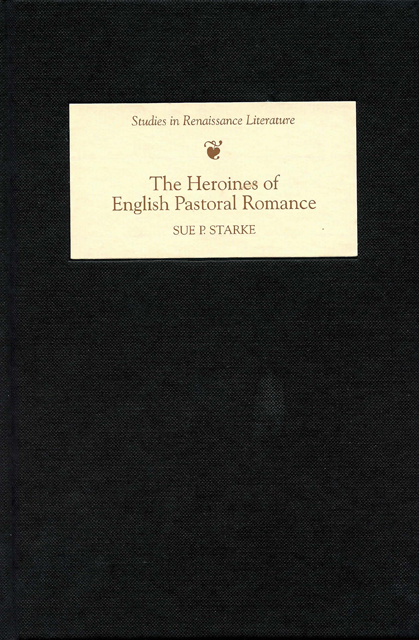Book contents
- Frontmatter
- Contents
- Acknowledgements
- Abbreviations
- Chapter 1 The Pastoral Romance Heroine in English Renaissance Literature
- Chapter 2 The Arcadian Prison: Chastity and the Defense of the Princesses in Sidney's Two Arcadias
- Chapter 3 Spenser's Romance Heroines: The Heroic and the Pastoral in Books 3 and 6 of The Fairie Queene
- Chapter 4 Growing Out of Pastoral: Wroth's Urania and the Female Pastoral Career
- Chapter 5 Fletcher's Clorin and Milton's Lady: The Performance of Chastity in Pastoral Drama
- Chapter 6 Milton's Eve and Marvell's Maria Fairfax: Wives and Daughters in the Pastoral Family Circle
- Bibliography
- Index
Chapter 5 - Fletcher's Clorin and Milton's Lady: The Performance of Chastity in Pastoral Drama
Published online by Cambridge University Press: 10 March 2023
- Frontmatter
- Contents
- Acknowledgements
- Abbreviations
- Chapter 1 The Pastoral Romance Heroine in English Renaissance Literature
- Chapter 2 The Arcadian Prison: Chastity and the Defense of the Princesses in Sidney's Two Arcadias
- Chapter 3 Spenser's Romance Heroines: The Heroic and the Pastoral in Books 3 and 6 of The Fairie Queene
- Chapter 4 Growing Out of Pastoral: Wroth's Urania and the Female Pastoral Career
- Chapter 5 Fletcher's Clorin and Milton's Lady: The Performance of Chastity in Pastoral Drama
- Chapter 6 Milton's Eve and Marvell's Maria Fairfax: Wives and Daughters in the Pastoral Family Circle
- Bibliography
- Index
Summary
The pastoral mode was a widespread and popular one in English Renaissance drama. Pastoral elements infuse everything from Lyly's plays to Shakespeare's comedies and later romances to the tragicomic entertainments of Daniel and Fletcher. The pastoral heroine of the stage is a major character type; Shakespeare's Rosalind (based on Lodge's Rosalynde) is perhaps his best-known non-tragic heroine, even today, but she combines conventional features of her pastoral predecessors. With her rhetorical facility and her own version of the pastoral romance loop, Rosalind falls squarely into the category of heroines with which we are concerned here. Shakespeare's As You Like It, however, is no longer chiefly read or appreciated through the pastoral lens. Its pastoralism is one of many elements that make it typical of its time, but that pastoralism is not the reason it is still performed and appreciated. Its generic association with pastoral is not an intrinsic element of its appeal. Other plays of the era, however, are less detachable from their pastoral contexts. A contemporary lack of feeling for the motifs of pastoral romance as they appear in a variety of generic contexts diminishes our pleasure and immediate grasp of Renaissance pastoral drama. The position of the pastoral heroine, her generic emplacement and natural and social relationships, delivers a significance to her travails that enriches our understanding of less approachable examples of English pastoral drama. Two such examples, linked by common language and themes, are Fletcher's The Faithful Shepherdess (1609) and Milton's A Mask at Ludlow (1634; published 1637).
Both of these pieces have posed interpretive problems for recent critics. Milton's Mask is a puzzle; it has been the subject of significant commentary within the last twenty years as attempts have been made to alternately justify or dismiss its purported obsession with sexual purity. For this reason, Milton scholars have regarded it variously as an early articulation of bourgeois values, a remnant of the author's personal psychosexual preoccupations, or the argument of an anti-Laudian political program; however, when we look at the masque next to an example of pastoral tragicomedy, the pastoral context may clarify some of the critical quandaries this work has presented to various readers.
- Type
- Chapter
- Information
- The Heroines of English Pastoral Romance , pp. 142 - 179Publisher: Boydell & BrewerPrint publication year: 2007
- 1
- Cited by



